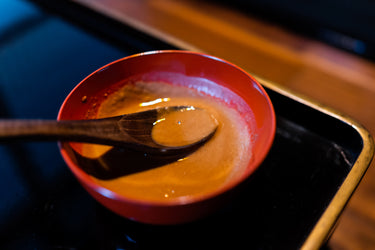What Is Miso Paste?

Miso is a paste made from a variety of fermented ingredients using a type of mold called koji. This traditional Japanese food has gained popularity the world over, and for good reason. Not only is miso rich in umami—the so-called fifth taste with a quality best described as savory with a delicious funk—consuming miso is associated with a reduced risk of death. Believed to have originated thousands of years ago in China, the ingredient was introduced to Japan in the 7th century, but its popularity increased dramatically during the Edo Period (1603 to 1868), when it evolved into the varieties we find today.
How is miso made?
The first step in making miso is to make koji. To do this, rice, soybeans, barley, or a combination of all three are combined with koji mold, a microorganism called Aspergillus oryzae, which has the honor of being Japan’s “national fungus.” The koji is then mixed with soybeans and/or grains and salt, and fermented again. This is when the trademark flavors of miso develop.
Not only used for making miso, koji mold is also used to ferment ingredients for making soy sauce, sake, and mirin. When foods are fermented with this mold, the starches and proteins are transformed, resulting in the trademark umami flavors that make the foods so delicious.
What are the main kinds of miso?
There are four main kinds of miso: Rice miso (kome miso) is the most common variety of miso, rice miso accounts for an estimated 80% of miso production in Japan. In the US, you’ll often find rice miso labeled as white miso. Soybean miso (mame miso), barley miso (mugi miso), and mixed miso (that is, miso made from a combination of the other ingredients), are less common, but also delicious. In the US you are likely to find miso labeled by color. Shiro, or white miso, is often a rice miso, while aka, or red miso, is made with a higher proportion of soybeans.
What are the benefits of miso?
Miso has a wide variety of health-promoting benefits. The live microorganisms that remain in the miso are gut-friendly (this makes them a probiotic food in the same category as sauerkraut, kefir, and kimchi). The paste is rich in vitamins and minerals and has benefits for both digestion and the immune system. Because miso is fermented, it can be stored in your refrigerator for a long time. A year is a safe bet, because although the fermentation means it can technically last indefinitely, cross-contamination or improper storage can lead to bad molds growing on the miso or oxidization.
Eating miso isn’t just about health, though. Its complex flavor adds a “what makes this so delicious?” quality to every dish.
7 ideas for using miso in your cooking
Good for more than just miso soup, this delicious paste can bring depth of flavor to both savory and sweet dishes. At high temperatures, the health-promoting microorganisms in miso will die off, so add it to cold dishes or stir into soups and stews after cooking to get the health benefits.
- Miso’s spreadable texture is just made for turning into a luxurious pasta sauce. In this NYTimes recipe for Five-Ingredient Creamy Miso Pasta, miso joins butter and Parmesan for something nearly Alfredo-like.
- Over at Serious Eats, J. Kenji López-Alt promises 5 minutes are all you need to make a miso-glazed salmon, perfect for serving atop rice with steamed bok choy or broccoli.
- You’ll never make regular blondies again once you’ve stirred a dollop of miso paste into the bakesale standard. Try out The Brick Kitchen’s recipe for Brown Butter, Miso, and Walnut Dark Chocolate Blondies.
- Miso elevates the humble PB&J to new heights in Bon Appétit’s Pecan-Miso Butter and Jelly Sandwiches, sure to be beloved by kids and grownups alike.
- Your Thanksgiving turkey is ready to be upgraded with a miso-rub, says Epicurious. It might just overtake stuffing as a family favorite, this year.
- Add a dose of miso’s health-promoting microbes to your salad dressing with Food Network’s simple Miso Vinaigrette. Drizzle it on everything from greens to grain bowls.
- Miso adds sophisticated nuance to these stunning Miso Caramel-Apple Danishes from Food & Wine. It’s a project recipe worth trying, or you can skip the danishes and just make the miso-infused caramel.
Sources:
Kusumoto, Ken-Ichi, et al. “Japanese Traditional Miso and Koji Making.” Journal of Fungi, vol. 7, no. 7, 20 July 2021, p. 579, https://doi.org/10.3390/jof7070579.
Saeed, Farhan, et al. “Miso: A Traditional Nutritious & Health‐Endorsing Fermented Product.” Food Science & Nutrition, vol. 10, no. 12, 15 Sept. 2022, https://doi.org/10.1002/fsn3.3029.





